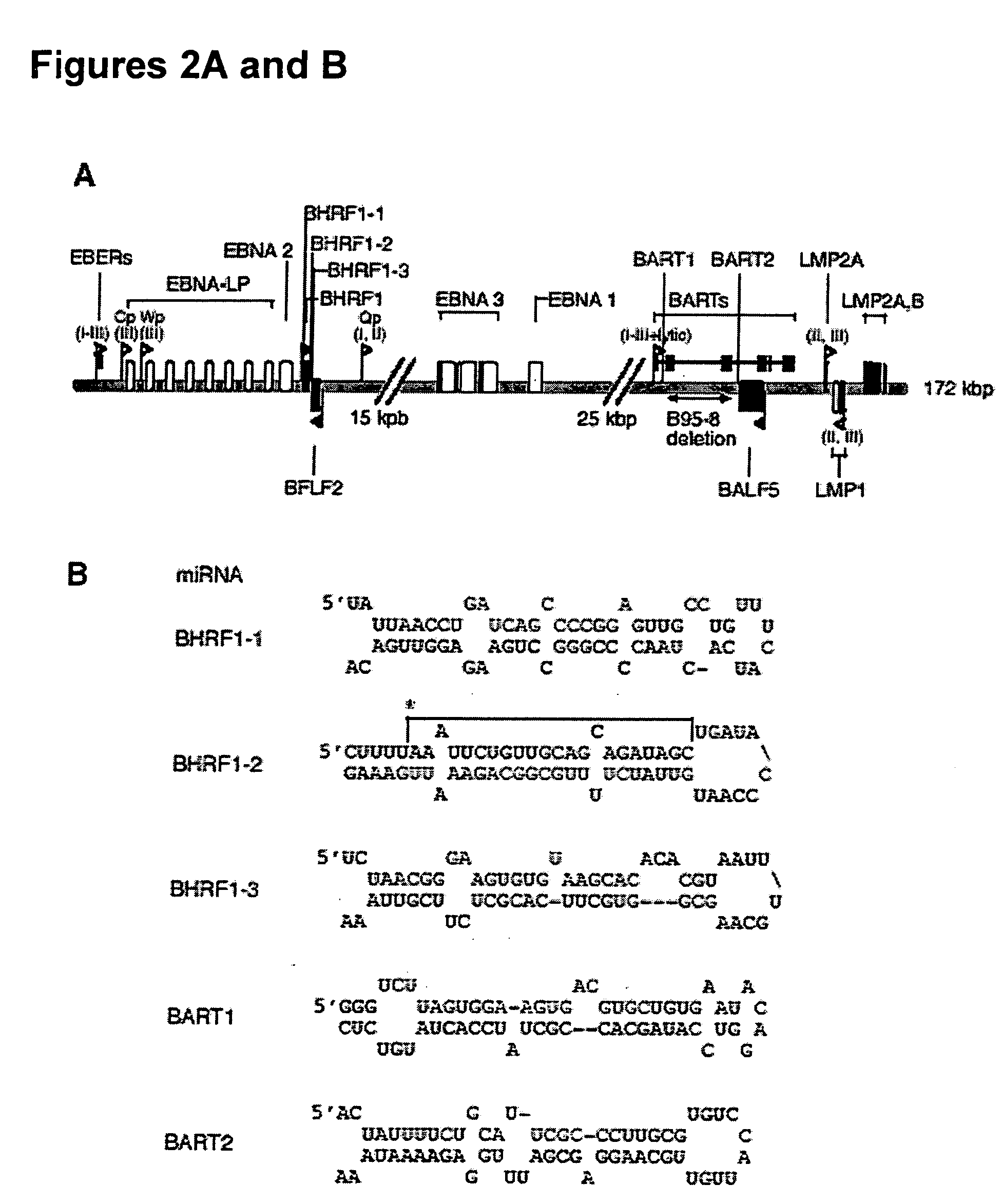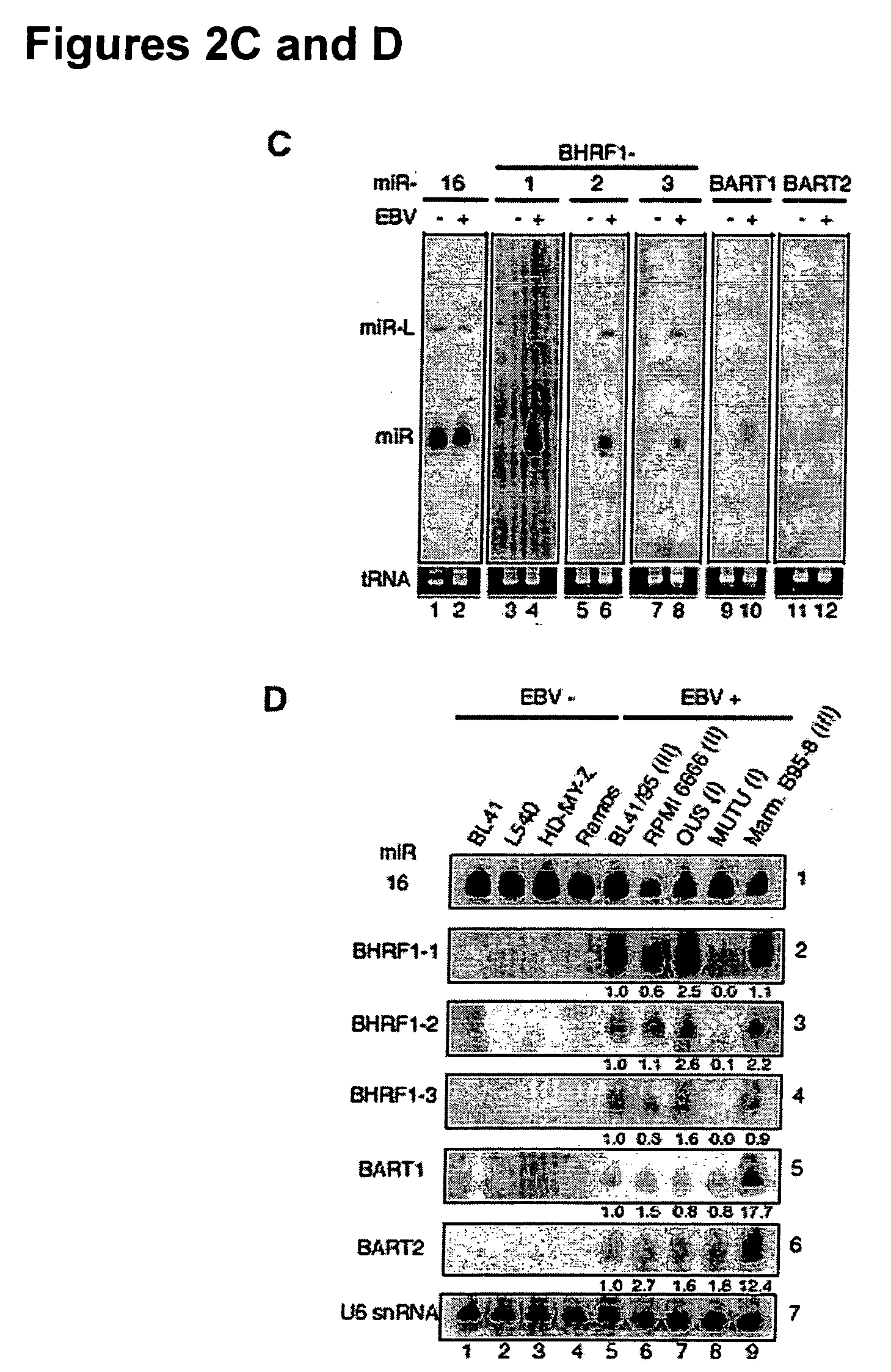DNA virus microRNA and methods for inhibiting same
a technology of dna virus and microrna, which is applied in the direction of dsdna viruses, drug compositions, peptide sources, etc., can solve the problems that the existence of microrna encoded by mammalian viruses has not been reported, and achieve the effect of inhibiting the activity of micrornp
- Summary
- Abstract
- Description
- Claims
- Application Information
AI Technical Summary
Benefits of technology
Problems solved by technology
Method used
Image
Examples
example 1
Materials and Methods
[0118] Cell lines and viruses. The EBV negative BL-41 and EBV positive BL41 / 95 cells were described previously (Torsteinsdottir et al., Int. J. Cancer 1989, 43:273) and were maintained in RPMI 1640 (Gibco) supplemented with 10% FBS. BL41 / 95 but not BL-41 contained EBV, as confirmed by Western blot analysis using antibodies against EBNA-1. For analysis of EBV miRNA expression, we also cultured Hodgkin's lymphoma (HD) cells L540 and HD-MY-Z (EBV negative) and RPMI 6666 (EBV positive) and the Burkitt's lymphoma (BL) cells Ramos (EBV negative), Ous and Mutu (EBV positive), and EBV positive Marmoset B95-8 cells that produce infectious B95-8 viral particles. These cell lines were also maintained in RPMI 1640 (Gibco) supplemented with 10% FBS. The KSHV positive BCBL1 cell line was described previously (Renne et al. Nat. Med. 1996, 2:342-346) and was maintained in RPMI 1640 (Gibco) supplemented with 10% FBS. For the KSHV studies, to induce viral replication, a total of...
example 2
Identification of EBV Encoded microRNAs
[0122] We examined a large DNA virus of the Herpes family, Epstein barr virus (EBV) which preferentially infects human B cells. We cloned the small RNAs from a Burkitt's lymphoma cell line latently infected with EBV. Surprisingly, we found 4% of the cloned small RNAs originated from EBV (Tables 1 and 2). Table 1. Composition of small RNA cDNA libraries prepared from non-infected (−) and DNA virus-infected human cell lines according to sequence annotation. The annotation was based on information from GenBank (http: / / www.ncbi.nih.gov / Genbank / index.html), a dataset of human tRNA sequences (http: / / rna.wustl.edu / GtRDB / Hs / Hs-seqs.html), a dataset of human and mouse sn / snoRNA sequences (http: / / mbcr.bcm.tmc.edu / smallRNA / Database), a database of microRNAs (http: / / www.sanger.ac.uk / Software / Rfam / microRNA / ), predictions of microRNAs (35), and the repeat element annotation of the HG16 human genome assembly from UCSC (http: / / genome.cse.ucsc.edu). The total ...
example 3
Predicated Target for Epstein Barr Virus Encoded microRNA
[0127] EBV latently infected cells can be found in three different latent stages (I to III, FIG. 2A) that are characterized by the expression of various subsets of the latent genes: six nuclear antigens (EBNAs 1, 2, 3A, B, C, and EBNA-LP), three latent membrane proteins (LMPs 1, 2A and 2B), two non-coding RNAs (EBERs 1 and 2) and transcripts from the BamHI A region (BARTs / CSTs) whose coding capacity is still controversial.
[0128] We isolated our small RNAs from a latent-stage-Ill EBV cell line that expresses all latent genes. In order to address if the expression of the EBV microRNAs is coupled with a specific latent stage, we probed for EBV microRNA expression in immortalized cell lines which are in different stages of latency, including Hodgkin's lymphoma (HD, latency II), Burkitt's lymphoma (BL) latency stage I cells, and virus-producing marmoset monkey lymphocytes B95-8 (latency III, with a fraction of 3 to 10% of cells e...
PUM
| Property | Measurement | Unit |
|---|---|---|
| Fraction | aaaaa | aaaaa |
| Fraction | aaaaa | aaaaa |
| Fraction | aaaaa | aaaaa |
Abstract
Description
Claims
Application Information
 Login to View More
Login to View More - R&D
- Intellectual Property
- Life Sciences
- Materials
- Tech Scout
- Unparalleled Data Quality
- Higher Quality Content
- 60% Fewer Hallucinations
Browse by: Latest US Patents, China's latest patents, Technical Efficacy Thesaurus, Application Domain, Technology Topic, Popular Technical Reports.
© 2025 PatSnap. All rights reserved.Legal|Privacy policy|Modern Slavery Act Transparency Statement|Sitemap|About US| Contact US: help@patsnap.com



